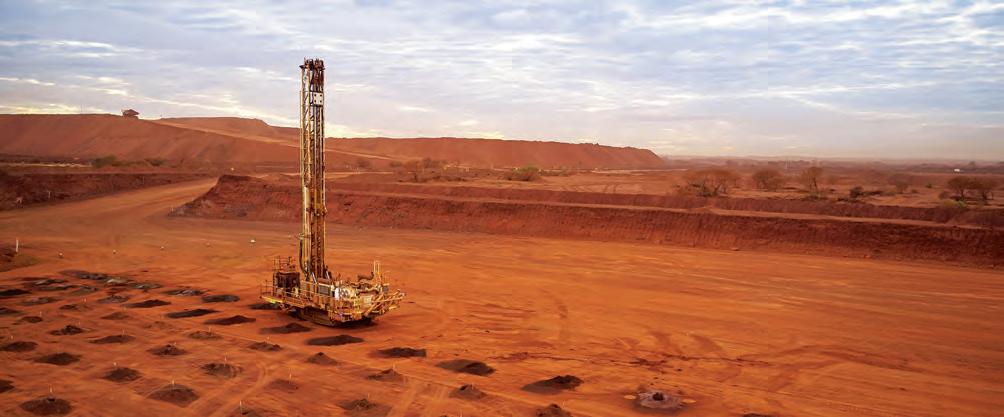
6 minute read
Protecting against cyclones
How mining companies prepare for cyclone season
Extreme natural events can pose dangers to a mining operation, the people that work on them and the communities in which they are based.
While cyclones are uncontrollable as they approach off the coast of Australia’s northern regions, the effect they have can be contained with the right preparation.
Mining operations can guard against the hazards posed by a tropical cyclone in a number of ways.
As per the famous quote of Benjamin Franklin, “if you fail to plan, you are planning to fail.” It’s an old adage that Australian mining companies have sensibly followed.
Pilbara iron ore miners Fortescue Metals Group and BHP felt the pinch at their operations as tropical cyclones hit the Western Australian region over the past year.
Fortescue was forced to suspend its rail activities and shipping operations from Port Hedland in the wake of Tropical Cyclone Veronica in March 2019.
Just a month later, BHP announced a potential loss of around six to eight million tonnes of production due to the Port Hedland closure.
The same region was put on alert when Tropical Cyclone Damien threatened to hit the Pilbara coast in February, bringing with it the risk of strong winds, heavy rain and dangerous storm tides.
Tropical Cyclone Damien was the strongest tropical cyclone to cross the Western Australian coast since category four Tropical Cyclone Christine in 2013, according to the Bureau of Meteorology (BOM).
The weather agency recorded a peak wind gust of 194 kilometres an hour as Tropical Cyclone Damien made a direct hit on the Pilbara town of Karratha.
Port Hedland, Dampier and Ashburton ports were all closed, while heavy rain drenched the Solomon and Karratha airports that service Fortescue and Rio Tinto’s iron ore operations.
Thankfully, Fortescue chief executive Elizabeth Gaines says the impact of the 2019/2020 cyclone season has been minimal (at the time of writing).
“While operations at Christmas Creek and Cloudbreak (in the Pilbara) were paused for a short period due to heavy rainfall, there was no impact on production,” Gaines tells Safe to Work.
The health and safety of Fortescue’s people is the company’s highest priority during an extreme weather event. MINING COMPANIES HAVE SHOWN THAT WHILE WEATHER EVENTS CAN BE UNCONTROLLABLE AT TIMES, THEIR IMPACT DOESN’T HAVE TO BE. VANESSA ZHOU WRITES.
Images credit: Fortescue Metals Group
Fortescue’s Christmas Creek mine survived Tropical Cyclone Damien unscathed.

“Prior to the cyclone season, we (completed) comprehensive assessments at all locations to ensure our facilities meet the required standards, and our people and management practices are prepared,” Gaines says.
Fortescue’s port, rail and mine infrastructure is also built to meet the highest specifications and accounts for the risk of extreme weather events, she adds.
Gaines says Fortescue has six stages of cyclone alerts that are closely aligned to the Department of Fire and Emergency Services’ (DFES) alerts cyclone warning system.
“We use accurate forecasts from Bureau of Meteorology and Weatherzone for cyclone tracking, which helps us keep our people safe and disruptions to operations to a minimum,” Gaines says.
“We work with the Pilbara Ports Authority and other operators to minimise impacts to ship movements during extreme weather events.”
Likewise, BHP remains on guard during the cyclone season, which BOM forecasts to run from November to April.
Australia’s largest mining company has an integrated system of four processing hubs and five mines, including Newman, Yandi, Mining Area C and Jimblebar in the Pilbara region.
If operations need adjustments due to impending weather impacts, they are strategically managed with safety as the first priority, according to a BHP spokesperson.
“We continually monitor the local weather situation in the areas in which we operate and implement appropriate measures as required to ensure the safety of our people and our operations,” the spokesperson tells Safe to Work.
“For example, when a cyclone or severe weather is on approach, our operations would stand up an incident management team to monitor the changing weather conditions.”
The company’s response depends on the situation, and this includes commencing tie-down activities of infrastructure and equipment, or onsite work suspensions during severe situations.
One pattern seems to be clear: communication is key for the miners to ensure the safety of the people and operations.
“During all escalated weather situations, we ensure we communicate with our employees and follow the advice of local authorities and emergency services, putting safety first at all times,” the BHP spokesperson says.
AS Tropical Cyclone Damien dissipated and turned into a low-pressure system over central Western Australia by mid-February, it left behind moderate damage to infrastructure and widespread vegetation damage, according to BOM.
The latest cyclone season’s impact has been mixed. Mount Gibson Iron, for example, has maintained its ore sales guidance for the Koolan Island mine for the current financial year.
Despite more than 330 millimetres of rain falling at Mount Gibson’s Koolan Island main pit over three days, the company’s readiness for cyclones looks to have paid dividends.
Rio Tinto, on the other hand, has suffered from the impacts of Tropical Cyclone Damien.
The cyclone caused the miner to reduce its Pilbara shipments forecast from 330–343 million tonnes down to 324–334 million tonnes.
Despite the incident, Rio Tinto is focussed on keeping disruption to a minimum and is on track to bring the Koodaideri iron ore project in the Pilbara to completion by 2021.
After all, the mining company has factored a degree of wet season interruption into its long-range planning, proving: “If you fail to plan, you are planning to fail.”
Australasia’s largest dedicated bulk handling conference & exhibition












BULKHANDLINGEXPO.COM.AU
IN CONJUNCTION WITH
MELBOURNE1-3 APRIL 2020




PROSPECTING FOR NEW BUSINESS?


HEAR FROM INDUSTRY EXPERTS
CONNECT WITH THE LARGEST RANGE OF SUPPLIERS


TICKETS NOW ON SALE
Platinum Sponsor
Association Partner Supporting Sponsor
Conference Sponsor Media Partners
AU ST RA LI A A USTR ALIA REVIEW REVIEW MHD Supply Chain Solutions
Scan the code to get more details about exhibiting opportunities.










